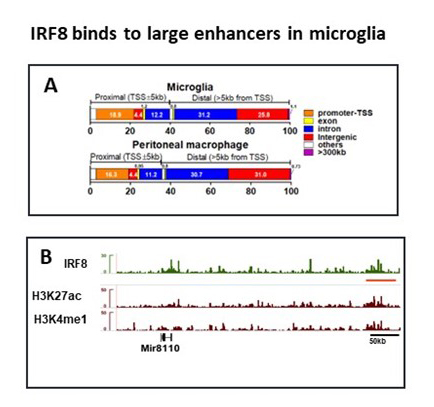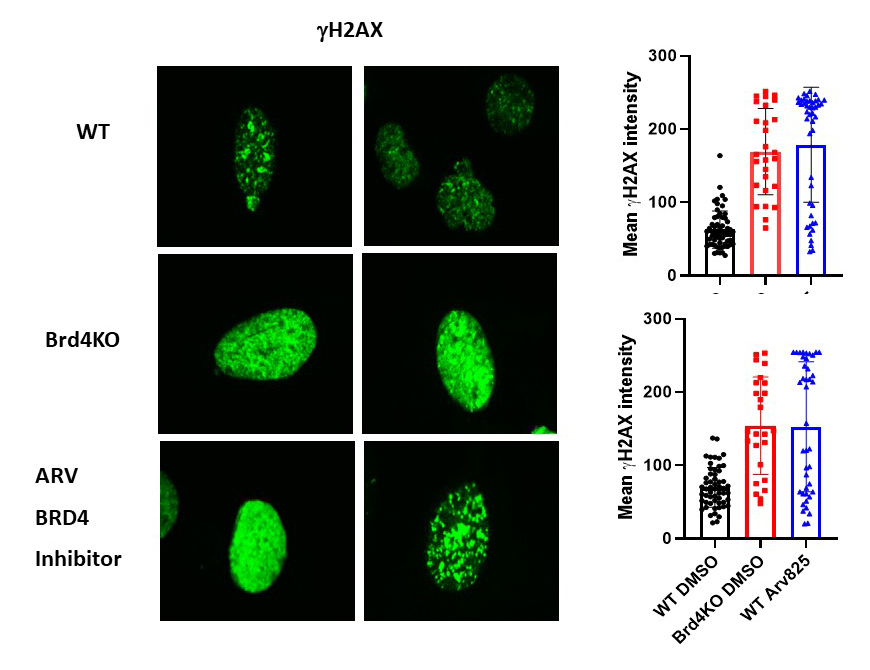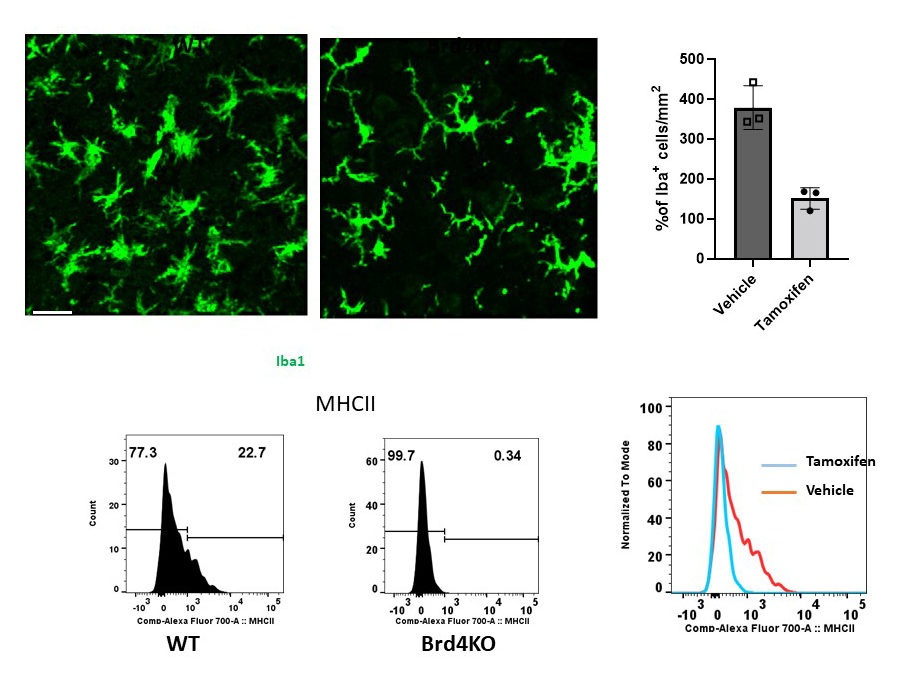Gene Regulation in Innate Immunity
- Keiko Ozato,
PhD, Head, Section on Molecular Genetics of Immunity - Anup Dey, PhD, Biologist
- Tiyun Wu, PhD, Staff Scientist
- Sakshi Chauhan, PhD, Visiting Fellow
- Kentaro Hoshi, MD, PhD, Visiting Fellow
- Fuki Kudoh, PhD, Visiting Fellow
- Eunju Lee, PhD, Visiting Fellow
- Keita Saeki, MD, PhD, Visiting Fellow
- Vishal Nehru, PhD, Contractor

The laboratory is interested in the role of chromatin and gene regulation in innate immunity. We study three nuclear factors, histone H3.3, BRD4, and IRF8. Histone H3.3 is a variant histone that is incorporated into nucleosomes during transcriptional elongation, a defining feature of this variant. Other canonical core histones are deposited into nucleosomes during replication. For this reason, H3.3 is thought to be involved in epigenetic memory created after transcription, although experimental evidence for memory formation/maintenance is scant. BRD4 is a bromodomain protein of the BET (bromodomain and extra-terminal domain) family, expressed broadly in many cells, from early embryos to adults. Through the bromodomain, BRD4 binds to acetylated but not unacetylated histones. BRD4 is thus called a “chromatin reader,” a type of regulatory factor capable of conveying epigenome information to gene expression. Furthermore, BRD4 binds to the elongation factor complex P-TEFb through the C-terminal domain, and drives transcription of many genes by driving RNA polymerase II to move through the gene body, generating nascent mRNA. Many recent reports point out that BRD4 promotes growth of cancer cells, including various blood cancers, by mediating the formation of super-enhancers involved in cell-cycle progression. IRF8, which we discovered in 1990, is a DNA–binding transcription factor that plays an essential role in innate resistance against a wide array of pathogens (Figure 1A for its structure). IRF8 is expressed mostly in cells of the myeloid lineage, including monocytes/macrophages, dendritic cells, and microglia. IRF8 is strongly induced when stimulated by interferons (IFN). In addition, it is upregulated when myeloid cells encounter pathogen-derived molecules and agents produced by stress. In turn, IRF8 activates many genes important for host resistance. IRF8–induced genes include those involved in autophagy and lysosome-mediated pathogen clearance; IRF8 does so by binding to small DNA motifs present in promoter and enhancer regions of the target genes.
BRD4 promotes cell-cycle progression by preventing DNA damage.
Cell proliferation depends on continuous rounds of cell-cycle progression, which are driven by sequential activation of transcription factors and other post-translational effectors. BRD4 inhibitors offer new therapeutic possibilities against cancer. However, the role of BRD4 in the proliferation of normal cells has remained elusive. We examined proliferation of embryonic fibroblasts from Brd4 conditional knockout (KO) mice. Cell-cycle analysis of wild-type (WT) and Brd4 KO cells showed that BRD4 is required for all stages of the cell cycle (Figure 4B). Transcriptome analysis found that many cell cycle–regulated genes were markedly downregulated in Brd4 KO cells, including ATM and ATR, kinases known to be critical for DNA–damage response. ATR was recently shown to be activated at S and necessary for G2-M passage. Our results indicate that BRD4 drives transcription of numerous cell cycle–regulated genes. Consistent with these results, BRD4 occupied numerous cell-cycle genes throughout all stages, as revealed by ChIP-Seq analysis.
Brd4 KO cells suffered from DNA damage at all stages of the cell cycle, as evidenced deposition of phospho(γ)-H2AX foci (Figure 4). DNA damage prompts DNA–repair response by a series of enzymes and activates p53, a central factor directing cell-cycle arrest and apoptosis. RNA-Seq analysis found that many genes important for DNA damage responses depend on BRD4 for expression. Together BRD4 controls DNA damage as an integral part of cell-cycle regulation.
RF8 sets microglia-specific epigenome structure and defines the transcriptome program.
Microglia are the sole cell type in the brain that protects from pathogen infection and restores neuronal injury. Microglia are also important for shaping neuronal development and cellular connections. Recent genome-wide SPN (single nucleotide polymorphism) analyses showed that genetic risk factors for Alzheimer’s disease (AD) are either exclusively or most highly expressed in microglia, but not in neurons. Thus, it is thought that microglia play a central role in AD onset and progression. Microglia originate from the embryonic yolk sac as a progenitor, and then migrate into the embryonic brain, where they differentiate into functional microglia in the postnatal stage. In adults, microglia are distributed throughout the brain, including the cortex and hippocampus. Previous reports demonstrated that Spi1(PU.1) (a transcription factor that plays a crucial role in myeloid cell development in vertebrates) and IRF8 take part in early progenitor differentiation in the embryonic brain. However, IRF8's function in adult microglia was not fully understood. We examined microglia from adult brain in Irf8 knockout (KO) mice. We found that Irf8 KO microglia have abnormal morphology and do not express several microglia-specific surface markers. We then sorted microglia from adult WT and Irf8 KO mice by FACS (fluorescence-activated cell sorting) and performed bulk and single-cell RNA-Seq. Results revealed that, without IRF8, many genes that bestow microglia-specific properties were missing or downregulated, including those encoding cell-surface markers such as P2ry12, Iba1, Cx3cr1, and Ccr5. On the other hand, some of IFN–stimulated genes (ISGs) and disease-associated microglia (DAM) genes expressed in AD microglia were expressed in Irf8 KO microglia (Figure 1B). In addition, we found that IRF8 is required for the expression of two transcription factors critical for adult microglia function, i.e., Sall1 and Batf3. Our results show that IRF8 directs a transcriptional cascade that defines the microglia transcriptome program.
It was important to determine the DNA sites in the microglia genome to which IRF8 binds, information that is missing in the literature. This was technically difficult, because the number of harvestable microglia is low. Modified Cut&Run assay provided reproducible IRF8–binding profiles. Our data showed that IRF8 binds mostly over distant enhancer regions, located upstream and downstream of its target genes (Figure 2). IRF8 binding sites were strongly enriched with DNA motifs containing GAAA. In some enhancers IRF8 binding was closely clustered. Some of these sites were within the large stretched enhancers enriched in H3K27ac histone marks. Large enhancers are known to support transcription of genes essential for cell type–specific properties. IRF8 containing large enhancers neighbored genes essential for microglia, including Sall1 and Batf3. Deletion of Irf8 led to loss of large enhancers associated with microglia-identity genes. Furthermore ATAC-Seq assay showed that IRF8 is important for setting open chromatin necessary for microglia’s large enhancers. Our results clearly show that IRF8 directs the formation of the microglia-specific epigenome landscape. Consistent with this view, DNA methylome profiles revealed extensive changes in methylation associated with IRF8 binding.
Despite the blood-brain barrier, microglia respond to external immune stimuli such as bacterial lipopolysaccharides (LPS), which induce inflammatory genes. We found that IRF8 is required for the expression of many inflammatory genes induced by LPS in microglia. We next sought to determine whether IRF8 impacts the brain’s health. Thus, we investigated whether IRF8 affects AD progression, using a mouse model of AD (5xFAD). 5xFAD transgenic mice accumulate plaques containing polymerized amyloid β peptides in the brain near microglia. Amyloid β plaques are thought to be the main cause of AD pathology, as they lead to neuronal death. We found that 5xFAD mice lacking the Irf8 gene have smaller amyloid plaques in the cortex, indicating that IRF8 facilitates plaque formation in this model (Figure 3A). Given that IRF8 shapes microglia identity, our observations are in line with previous reports that microglia worsen AD pathogenesis in the 5xFAD model. NeuN immunostaining found evidence of substantial neuronal loss in the one-year-old 5xFAD brain. However, NeuN immunoreactivity was more intense in Irf8KO 5xFAD brain, indicating reduced neuronal damage in the absence of Irf8 (Figure 3B). These results are consistent with the view that microglia can negatively impact AD pathogenesis.
Figure 3. IRF8 modulates Alzheimer's disease progression in mice.
A. Large amyloid β plaques accumulate near microglia in 5xFAD brain, but amyloid plaques are smaller in Irf8 KO 5xFAD brain (cortex). 6E10: polymerized amyloid plaques; Iba1: surface marker for microglia.
B. NeuN immunostaining quantification
Figure 3. IRF8 modulates Alzheimer's disease progression in mice.
A. Large amyloid β plaques accumulate near microglia in 5xFAD brain, but amyloid plaques are smaller in Irf8 KO 5xFAD brain (cortex). 6E10: polymerized amyloid plaques; Iba1: surface marker for microglia.
B. NeuN immunostaining quantification
BRD4 in microglia and neuroinflammation
To further study the transcriptome and epigenome regulation of microglia, we began investigating the function of BRD4. We constructed mice in which Brd4 is knocked out in microglia, by tamoxifen injection, in adult brain (Brd4f/f Cx3cr1Cre). To study how BRD4 regulates neuro-inflammation, we analyzed a mouse model of multiple sclerosis: experimental allergic encephalomyelitis (EAE). EAE causes microglia to proliferate from the resident progenitor cells. These microglia, along with T cells, and macrophages infiltrating from periphery, promote demyelination and neuronal damage, which results in paralysis. Brain histology revealed that the number of microglia is considerably reduced in the Brd4 KO brain in EAE (Figure 5A). In addition, Brd4 KO microglia exhibited aberrant morphology, with stunted extensions, and failed to express MHCII, a representative marker for active microglia (Figure 5B). Remarkably, mice with the microglial Brd4 deletion had less demyelination, resulting in reduced tissue damage, and reduced paralysis. Neuro-inflammatory cytokines and chemokines such as Il1b were also lower in Brd4 KO EAE microglia. These results indicate that BRD4 is required for microglia to detect incoming antigenic and inflammatory signals, interacting with and further stimulating infiltrated T cells. Our study thus revealed that BRD4 plays a central role in the pathogenesis of neuroinflammation. Consistent with these data, our recent data indicate that BRD4 promotes AD pathogenesis.
Figure 6. BRD4 promotes neuroinflammation in the mouse model of multiple sclerosis (EAE).
Brd4 KO microglia in EAE (experimental allergic encephalomyelitis). Microglia were visualized by Iba1 immunohistology. The numbers of microglia are reduced in Brd4 KO brain (quantification on the right). MHCII expression is absent from Brd4 KO microglia. Brd4 deletion in microglia reduces EAE disease phenotypes.
Figure 6. BRD4 promotes neuroinflammation in the mouse model of multiple sclerosis (EAE).
Brd4 KO microglia in EAE (experimental allergic encephalomyelitis). Microglia were visualized by Iba1 immunohistology. The numbers of microglia are reduced in Brd4 KO brain (quantification on the right). MHCII expression is absent from Brd4 KO microglia. Brd4 deletion in microglia reduces EAE disease phenotypes.
Publications
- IRF8 defines the epigenetic landscape in postnatal microglia, thereby directing their transcriptome programs. Nat Immunol 2024 10:1928–1942
- Immature functional development of lumbar locomotor networks in adult Irf8-/- mice. Front Neurosci. 2024 17:1234215.
- Murine IRF8 mutation offers new insight into osteoclast and root resorption. J Dent Res 2024 103(3):318–328
- BRD4 directs mitotic cell division by inhibiting DNA damage. bioRxiv 2023 25:2023.07.02.547436
- Chromatin structure undergoes global and local reorganization during murine dendritic cell development and activation. Proc Natl Acad Sci USA 2022 119(34):e2207009119
Collaborators
- Robert J. Crouch, PhD, Section on Formation of RNA, NICHD, Bethesda, MD
- Daisuke Kurotaki, PhD, Kumamoto University, Kumamoto City, Japan
- Justin Milner, PhD, University of North Carolina, Chapel Hill, NC
- Tomohiko Tamura, MD, PhD, Tokyo University, Tokyo, Japan
- Vivek Thumbigere Math, DDS, PhD, University of Maryland, School of Dentistry, Baltimore, MD
Contact
For more information, email ozatok@mail.nih.gov or visit https://www.nichd.nih.gov/research/atNICHD/Investigators/ozato.







